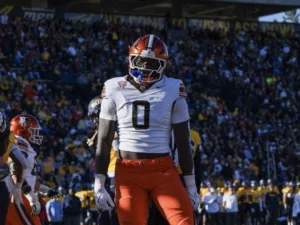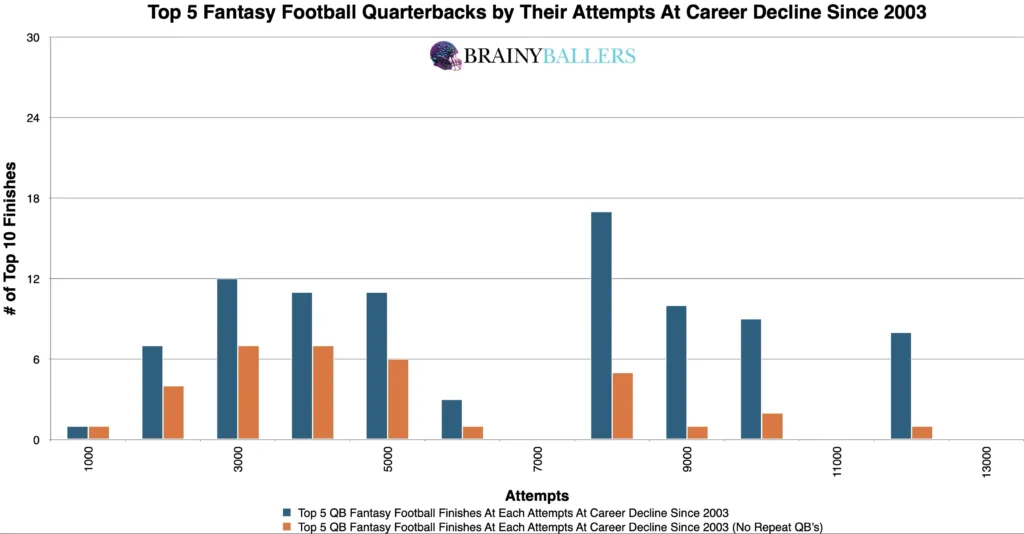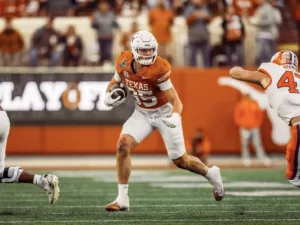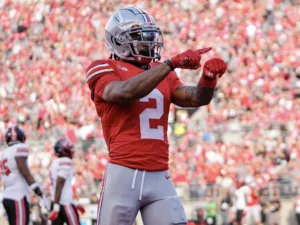
Tight Ends: Can College Yardage Help Predict NFL Success?
When evaluating talent for the NFL, analysts often look at a player’s college performance to predict their professional success. In our 64-part


Part 56 of our “Does It Matter?” series focused on identifying when a quarterback is likely to decline in their career, crucial for fantasy football players looking to maximize player and roster value by understanding where their Quarterback is on their career arc. In this article, we examined fantasy leaderboards since 2003 and pinpointed a threshold where quarterbacks should be sold to avoid diminishing returns. Further, we found Quarterbacks who are on the brink of that threshold and therefore should be considered a sell soon rather than later. Here are all of our findings:
Our analysis began with examining the top 30 fantasy football Quarterbacks since 2003. We excluded all rookie season data entries to not allow for the typical rookie struggles to skew our data. A key term within this study is “bottom 10”, which refers to players placing 21st-30th each season.
Our analysis began by identifying the beginning of career declines for each Quarterback by observing when they failed to return to a -20% performance buffer following their peak season, measured by their passing yards. For example, if they have a career peak (record) season at 4,000 yards, they would need to have at least 3,200 Yards the next season for it to not be considered a legitimate decline.
What if the QB steadily declines for less than 20%? Can they decline until they have a zero yardage season to never have a “decline”? Staying in the buffer zone the next season after a peak isn’t considered a decline. However, if consecutively dropping less than 20% over multiple seasons, it is once they drop out of the peak yardage season’s buffer zone that is considered a decline. This is to prevent QB’s from continuously extending buffer zones indefinitely to avoid ever recognizing a decline.
What if they drop from 5,000 Yards to 3,800 Yards? They are still producing at a high level… A QB must be under 3,500 yards and meet all the other prerequisites we just detailed in order to be considered a decline. In other words, a QB can drop from 4,800 yards to 3,501 Yards the next season and not have that considered a decline, since 3,500 yards is still a great performance. My personal goal of this was to find when a decline occurs PAST a point where they are not worth starting on my fantasy teams.
Our first goal was to see how often top performances resulted in longer careers. Therefore, we built an averages chart which divided leaderboards into 4 groups: top 5, top 10, 11th-20th, and 21st-30th place. As you can see, in 20/21 seasons (95.2%), Quarterbacks achieving a top 5 finish had equal or longer careers than those in the “bottom 10”. To explain the obvious, here is what this says: good production on the field correlates with longer careers.

Further, we classified finishers into top and bottom 5 groups since 2003, segmenting data in 1,000 yard increments. For each data entry, we used the players’ attempts at career decline number. The weight and distribution across both charts highlighted – once again – that higher fantasy rankings correlated with increased attempts. Those two charts can be seen below, with the top 10 coming first:


Our primary goal was to discover a threshold where more elite performances and less subpar performances cross over. This indicates that once quarterbacks surpass the specified number of passing attempts, they are likely to have already succeeded, therefore they earned the right to continue playing. Also, this would help pinpoint the moment in careers at which Quarterbacks are typically deemed failures and no longer have the right to keep playing.
To achieve this, we created a differences chart. This subtracted bottom 5 results from top 5 since 2003 across 1,000 attempt ranges beginning at each indicated attempt. The chart’s desired outcome is a negative number for unique differences (Orange) and a positive number for non-unique differences (Blue). This would indicate the top level consistency we are hoping for. Our findings from this revealed that 3,000 attempts appears to be the differentiating threshold between successful and unsuccessful Quarterbacks.

Next, we utilized our spreadsheet to verify the optimal range our differences chart revealed. After conducting multiple tests around our 3,000 attempt threshold, we validated it. Our analysis showed that quarterbacks with over 3,000 attempts have a 46.8% higher likelihood of appearing in the top 5 compared to the bottom 5. This range, therefore, will be the subject of this research going forward. To sum this up: This shows that if you are successful, you more than likely to continue past the 3,000 career passing attempt threshold. If you are not successful (defined as not finishing top 5 in fantasy leaderboards), your career is more than likely over as a Quarterback in the NFL.
In our breakdown of the top 30 fantasy finishers, we broke them down further into top 10, 20, and 30 groups.
Through this, we found a critical threshold of 10,161 attempts. This is if you exclude a big outlier named Tom Brady. Essentially, if you hold a quarterback who is near 10,161 career passing attempts, it’s time to sell for anything you can get unless you are competing and have no other options.
Due to these findings, Career Decline could play a factor in our Post-Rookie Star-Predictor Score (SPS) model. Since 10,161 attempts is the highest seen since 2003 in the top 10, this will be the critical value for the Post-Rookie SPS in regards to career declines. The Star-Predictor Score (SPS) is a scouting tool designed to maximize investment potential and reduce risks when drafting rookies in Fantasy Football. It is proven to have a higher accuracy than draft capital alone to predict fantasy success. The SPS includes 13 to 17 metrics, with the exact number varying by the player’s position. All these metrics are pre-NFL, and some are invented by us, providing a complete analysis of a player’s analytical profiles. The SPS gained widespread notoriety for its high accuracy, having made it on Barstool and The Pat McAfee Show. The SPS can be found here.

Utilizing standard statistical methods, we determined a Pearson correlation value of 0.528 between fantasy points and the corresponding career attempts at decline of the Quarterback who produced those fantasy points. This signifies a substantial correlation between attempts at career decline and fantasy production. In other words, Quarterbacks who are successful have longer careers. While analyzing world-class athletes as we are, a Pearson value above 0.1 or below -0.1 is considered noteworthy. For reference to something that everyone acknowledges matters in prospect scouting, and to show the accompanying Pearson value, RB draft capital prevailed a -0.234 Pearson value.
To sum it up: when a QB enters the league, it’s a race to finish top 5 in Fantasy Football before their 3,000th career passing attempt. If they don’t, they are instant sells, as the clock has more than likely ran out for them. If they do, the average top 5 QB begins their decline at their 6,547th attempt. The longest lasting Quarterback was 10,161 career attempts. I’m personally selling around the 7,000 attempt, roughly one season after the average mark. You can adjust within those numbers due to what you are willing to risk. Also, finding top 5 QB’s before they reach their 3,000th career attempt could prevail long term profits, as they probably haven’t peaked quite yet.
Using these insights, we found notable QBs who should potentially be traded away, or at least monitored closely.
Approaching 3,000 Career Attempts Without a Top 5 Season (monitor):
Big names past the average and/or near the 10,161 Career Attempts Critical Decline Threshold:
What 3 metrics matter the most when scouting a rookie Quarterback? What threshold should Quarterbacks achieve within those metrics to be considered an elite prospect? How much should you value those stats above all other stats? Couldn't answer those questions? Rest easy, we have it handled for you. That's what this chart answers. Sort by importance and/or filter by position. Unlock by signing up with the links provided. $9.99/Year or $24.99 Lifetime access. Cancel anytime.
This study confirms the theory that if you succeed, you are more likely to have a longer career than not, which may be stating the obvious. Due to this, I am targeting players such as Justin Herbert this season, whose value has diminished due to recent play, but he is still extremely young in terms of career attempts with 2,890 career attempts at the time of this writing.
Our series has always sought to push the boundaries of sports analytics. This latest installment reaffirms our commitment to uncovering the hidden dynamics that define the game. Every Saturday, we’ll dive into intriguing questions, bust myths, and settle debates with thorough analysis. We welcome your input. Therefore, please leave comments or reach out with topics you’re eager to see dissected. Premium Analytics subscribers get priority. All of our research can be found on our Analytics Page. Up next on our agenda for Part 57 of “Does It Matter?” will be an examination of College Quarterback PFF Passer Ratings: Does it matter? If so, what’s the PFF Passer Rating threshold necessary for NFL success? Mark your calendars; every Saturday we shed light on the topics that matter to you.


BrainyBallers Buy-Hold-Sell Chart (All Players)
Get Your Order 100% Refunded By Predicting The Next SuperBowl Winner!

When evaluating talent for the NFL, analysts often look at a player’s college performance to predict their professional success. In our 64-part

In our 63-part analytical series, “Does It Matter?”, we next wanted to look into the intriguing question of whether a Tight End’s

For our 61 part “Does It Matter?” series, we looked into whether a Wide Receiver’s College Yards After Catch per Reception (YAC/Rec)
© 2023 BrainyBallers | All Rights Reserved